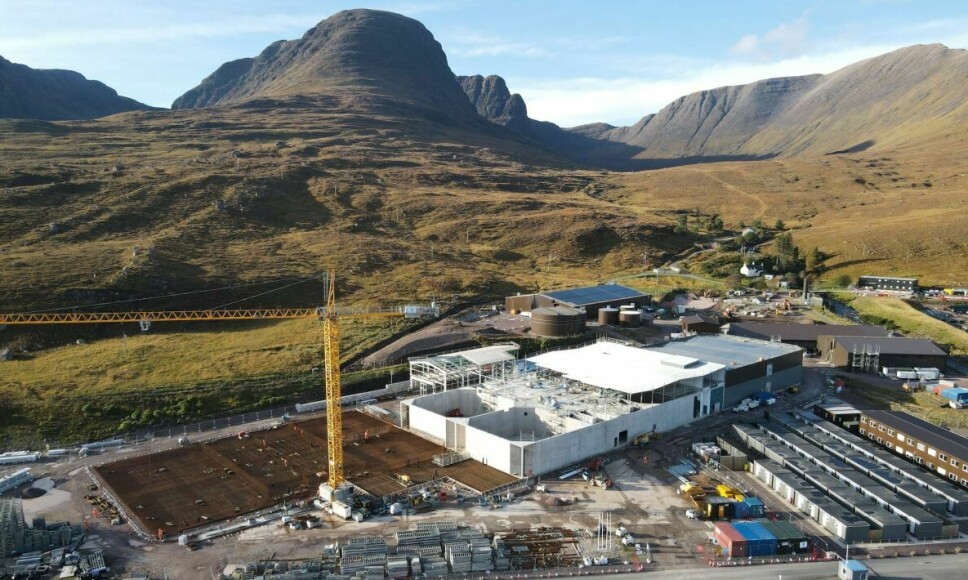
Bakkafrost slashes Scotland harvest forecast by 10,000 tonnes
Guidance reduced to 25,000 gwt after mortalities that cost company £14.2m
Faroes-based salmon farmer Bakkafrost has slashed its 2022 harvest forecast for its Scottish operations from 35,000 gutted weight tonnes to 25,000 gwt after high mortalities during the third quarter, particularly in the Loch Fyne and East Lewis and Harris areas.
“We are not satisfied with the biological performance in the Scottish farming segment, where mortality rates have been higher than expected in this quarter. This reminds us, that we still face challenges while we await larger and better quality smolt,” said chief executive Regin Jacobsen in a press release.
The Scottish farming segment made an operating loss of DKK 137 million (£16 m) in Q3, worse than the DKK 81 m operating loss made in the same quarter last year.
Bakkafrost had incident-based costs of DKK 121 m, or £14.2 m (Q3 2021: DKK 69 m). For the first nine months of 2022, the Scottish operation has made an operating loss of DKK 149 m. It lost DKK 36 m over the same period last year.
Significant biological challenges
“In Scotland, farming conditions in Q3 2022 have followed the normal seasonal pattern with significant biological challenges and higher mortality,” Bakkafrost said in its Q3 2022 report published today. “Especially the Loch Fyne and East Lewis & Harris areas have been affected and suffered increased mortality.
“The negative development in the quarter was a continuation of the increased mortality in late Q2 2022, which in particular affected farming sites with fish previously compromised in H2 2021.
“The mortality levels in Q3 2022 have been higher than expected and caused by different reasons, such as gill-related issues.
“In late September 2022, the new 4,000m³ live fish carrier (wellboat) with freshwater treatment capacity, as well as an innovative in-line freshwater-based sea lice removal system was introduced in the farming operation in Scotland. This vessel can efficiently do dual treatments for gill-related issues as well as sea lice removal in one operation, thereby improving fish welfare while applying minimum stress on the fish.
“The results have been successful and together with the second live fish carrier in operation, Bakkafrost has secured proficient treatment vessel capacity in Scotland.”
Larger smolts
Bakkafrost’s strategy for improving performance in Scotland is based around producing much larger smolts with an average weight of 500 grams. These will be more robust than the smaller fish Bakkafrost Scotland currently stocks at its marine sites and will spend less time exposed to biological threats such as sea lice, and plankton that can cause gill disease.
The company has been expanding the capacity of its hatchery at Applecross, which will eventually produce 10 million 500 g smolts per annum. Two other hatcheries, in the north and south of Bakkafrost’s Scottish region, will also be built, taking capacity to 18 m half-kilo smolts.
“In Q2 2023, we will reach an important milestone in Scotland as we expect to release the first batch of large smolt from our Applecross hatchery,” said Jacobsen.
Risk mitigation
“In the meanwhile, good biological risk mitigation is important and freshwater treatment capacity plays an important role here.
“Unfortunately, our new wellboat for Scotland was delayed, but was finally in operation in late September. Hereby we have significantly upscaled our freshwater treatment capacity which is now finally at a sufficient level. The new 4,000m³ wellboat can treat for gill health issues as well as remove sea lice in one gentle treatment and the results so far are promising.”
The average weight of smolts stocked in Bakkafrost’s Scottish marine sites in Q3 was 107g, which is 9% higher than in Q3 2021.
The average weight in 2023 is expected to increase to around 150-175g. Bakkafrost said the number of released smolt next year will be lower than previous years as the focus is on stabilising the operation before increasing the volume.
Success in the Faroes

Bakkafrost’s biological and financial results in the Faroes, where the company’s large-smolt strategy is further advanced, have been the opposite of those in Scotland.
The Faroese farming segment made an operating profit of DKK 444 m (Q3, 2021: DKK 135 m).
“We are pleased to see continuing strong biological performance in the Faroe Islands with strong growth, all-time low sea lice levels and increased average harvest weights,” said Jacobsen.
“We are also pleased with the positive results from the implemented changes in the large-smolt production regime in the Faroe Islands. This has resulted in more robust smolt with better biological performance.
“Declining mortality levels in the farming operation from the smolt produced after the changes were implemented demonstrate the impact of these changes for our farming operation in general and large-smolt production in the Faroe Islands and Scotland.”
Profit almost doubles
Bakkafrost Group delivered a total operating EBIT of DKK 325 m (DKK 71 m) in Q3 2022 and made a profit of DKK 249 m (DKK 131 m).
Total harvested volumes for Q3 2022 were 25,000 gwt (21,900 gwt):
- FO: 16,900 gwt (14,900 gwt),
- SCT: 8,100 gwt (6,900 gwt).
Total harvested volumes for the first nine months of 2022 were 66,100 gwt (71,100 gwt):
- FO: 47,400 gwt (46,500 gwt),
- SCT: 18,700 gwt (24,600 gwt).
Harvest volumes for 2022 in the Faroe Islands are expected around 68,000 gwt and 25,000 gwt in Scotland, giving a total of 93,000 gwt.
In 2023, Bakkafrost expects to harvest around 68,000 gwt in the Faroe Islands and 30,000 gwt in Scotland, giving a total of around 98,000 tonnes gutted weight.























































